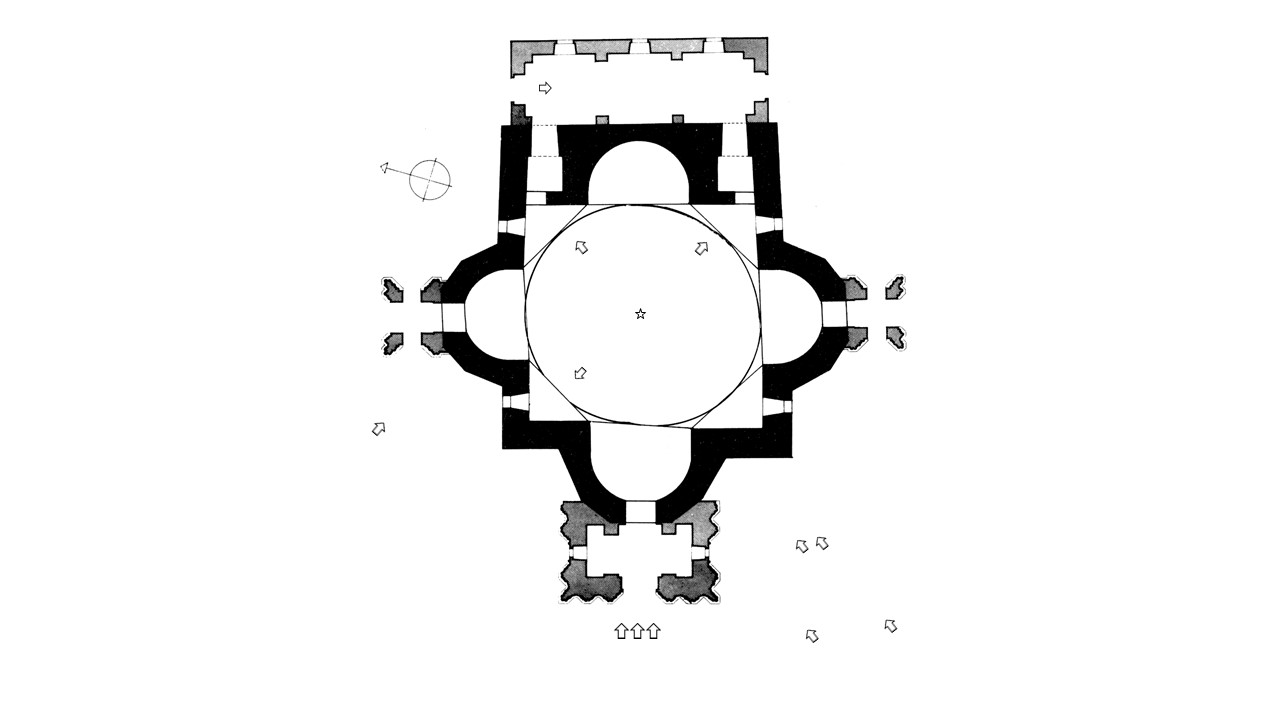Diana Grigorian
The Church of the Holy Apostles in Kars was built by Bagratid King Abas I (929/930-953) between 930 and 942. The church is located at the base of the castle of the same name. The church is a centrally-planned domed tetraconch, and is similar in design to the seventh-century church of St John in Mastara. The exterior of the polygonal drum of the dome is decorated with blind arcading with pairs of engaged twisted columns and cushion capitals (twisted columns are part of the arcade order of Ejmiacin Cathedral, Zarnja Church and St Karapet Church in Khtzkonk Monastery, 7th century). The archivolts of the arcade (and one of the archivolts of the windows) are decorated with a band of palmettes framed by a twisted moulding (this ornament is used in the decoration of Sts. Peter and Paul’s Church of Tatev Monastery, 895-906 and the style probably originated in Abbasid art).
Twelve standing human figures are carved in low relief between the archivolts of the drum, most of which are depicted in a praying position or with their arms placed across their chests (relief images between archivolts appear in Armenian architecture of the 7th century, the most famous are Zvartnots and Hnevank). There are three figures with different features: one of the figures stands beside a tree, while the figure next to him has a serpent at each side of his head, the third one appears to carry a hammer-like tool (such figures are carved in the spandrels of the Zvartnots Cathedral). The name of the church and the number of the figures have led art historians to see here images of the Apostles or the theme of the Ascension. It is important to note, however, that medieval authors refer to the church simply as ‘the Cathedral’, and that the name ‘Holy Apostles’ is first recorded in the second half of the 19th century. Stylistic and iconographic analysis of the figures show that they have greater parallels with donor portraits created in the 10th century.
The cornice of the drum is carved with an interlaced band of three strands (a variation of an ornament, widely used in 7th century Armenian architecture, for example, Dvin Cathedral). The cornice below the lower roofs has a band of intersecting lozenges and rosettes. The windows of the drum are plain, while the archivolts of the windows are decorated with geometric patterns (there are simplified variations of the same ornaments used in Armenian architecture of the 7th century). On the outer northern, western and southern walls of the church there are rectangular plaques decorated with crosses, stars and interlaced patterns. On the southern wall of the church there is a relief of a lion carved on a slab (it may be associated with the royal family). Other than the twelve figures on the drum, there is another figure carved in low relief above an oculus in the northern side of the western apse. This figure, flanked by snakes, is traditionally believed to be St Gregory the Illuminator, who was imprisoned in a snake-infested dungeon by the king. Figures flanked by snakes also appear in the decoration (on and below the archivolts) of Sts. Peter and Paul’s Church of Tatev Monastery (the meaning of the reliefs remains unclear, therefore more research is needed to better understand the meaning and the connection between the two churches).
Inside, the surface of the dome is divided by ribs. There are four sculptures on the keystone of each squinch which are meant to be the symbols of the Evangelists: an ox, an eagle and two human heads (St Mark’s symbol, the lion, is replaced with a human head). There are four smaller reliefs carved between the arches of the squinches and the apses (two human heads, the head of a ram and a mammal). The meaning of the reliefs is still unclear.
Small porticoes, the sacristy and the ornate stone iconostasis (in the interior) were built after the Russians captured Kars in 1877, and the church was converted into a Russian Orthodox church. It currently functions as a mosque.
Interactive Plan

Image Gallery
Bibliography
- Anecʿi, S. Havakmunk i groc patmagrac haghags gyuti zhamanakac anceloc minchev i nerkajs cajrakagh arareal, Aradjaban Arshak Ter-Mikelean (Vagharshapat, 1893), 99.
- Asoghik, S. Patmutyun tiezerakan (St Petersburg, 1885), 171-173.
- Ayrivanecʿi, M. Patmutyun hayocʿ, i luys encayac Mkrtich Emin (Moscow, 1860), 56.
- Cone, L. Armenian church architecture (New York, 1974), 66.
- Der Nersessian, S. L’art armenien (Paris, 1977), 107-108.
- Donabédian, P. & Thierry, J. M., Les Arts arméniens (Paris, 1987), 167.
- Grigoryan, D. ‘Karsi S. Arakeloc tachari tmbuki qandaknery’, Eritasard hay arvestabanneri gitakan hingerord nstashrdjan: Nstashrdjani nyuter, A. Asatryan, ed. (Yerevan, 2011), 229-239.
- Kazaryan, A., Kafedral’nij sobor Surb Echmiadzin i wostochnokhristianskoe iskusstwo IV-VII wekow (Moscow, 2007), 168-171.
- Mnacakanyan, S. Hay ashxarhik patkeraqandake IX-XIV darerum (Erevan, 1976), 66-67.
- Matevosyan, R., Haykakan zinanshanner (Erevan, 1994), 31.
- Russell, J. R. ‘A bas-relief on the Cathedral of the Holy Apostles at Kars, Armenia’, Armenian and Iranian Studies (2004), 1168-1169.
- Thierry, J.-M. La Cathédrale des Saints-Apôtres de Kars (930-943) (Louvain-Paris, 1978), 5-6, 46-63.


